Most people experience at least one skin rash in their lifetime, and most of the time it’s harmless. However, in some cases, these rashes can be caused by serious conditions like cancer or HIV infection, so it’s important to see your doctor if you’re concerned about your rash’s cause and/or symptoms.
What causes skin rashes? Is it contagious? Are there any home remedies? Here are the answers to your most frequently asked questions about skin rashes, including the symptoms, possible causes, and how to treat them.
This guide will help you identify the most common skin rash causes as well as the many different types of rashes you may experience. You will also find images of a variety of rashes to help you diagnose your own condition.
Skin Rashes Caused by Exposure to Chemicals
Skin rashes are a symptom of something else, either an allergy or a skin condition. They can be brought on by exposure to chemicals at work or home, which is why it’s important to ask your doctor for guidance if you think you have skin rash causes other than an allergy. One skin rash that develops after being exposed to chemicals is a condition called toxic epidermal necrolysis (TEN), which can affect any part of your body from your head to your toes.
Skin rashes can also occur when you expose your skin to direct sunlight or from excessive scratching. Skin rashes that are caused by exposure to chemicals typically look like raised red bumps on your skin, which may be itchy, painful or both. Chemical-induced skin rashes may also be accompanied by swelling or blisters on your skin.
Skin Rashes Due to Medication
Skin rashes can be caused by a number of things, but most commonly occur due to an allergic reaction to a medication. Medications can cause rashes in a number of ways. Some medications cause allergic reactions which may result in itchy skin, while others may cause direct damage to skin cells, resulting in inflammation and swelling. Check with your physician if you believe your medication is causing or worsening your skin rash so that alternative treatments may be considered
If you’re taking a new prescription drug, it is especially important to report any skin rash or itchiness to your doctor as soon as possible. While most skin reactions go away once you stop taking your medication, it’s best to figure out exactly what is causing them before that happens so you can adjust your dosage if necessary or move on to another treatment option entirely.
Fungal Infections
A fungal infection is a skin rash caused by a fungus. Fungi are like little plants, growing on top of or inside your skin. Some types of fungi can cause an infection called dermatophytosis, which you might also hear called ringworm. There are actually several different types of fungal infections that can cause skin rashes.
Fungal infections are a common cause of skin rashes. Ringworm, which is caused by an infection in the skin that thrives in warm, damp areas is a fungal infection. Athlete’s foot is another type of fungal infection that can cause a skin rash.
Pregnancy-Related Skin Changes that Can Cause Rashes
When you’re pregnant, your skin is different from what it was before you were pregnant. That’s because some hormones in your body (progesterone, estrogen, and relaxin) have changed how your skin works to accommodate for a growing baby.
Maternal skin rashes are usually caused by pregnancy-related changes in hormone levels. Skin rashes that appear during pregnancy often resolve themselves postpartum, although many women will continue to suffer from them during their childbearing years.
Spider Bites and Bee Stings
Both bee stings and spider bites can cause painful skin rashes, bug bites, hives (urticaria), and fungal rashes.. The difference is that bee stings come from bees while spider bites come from spiders (obviously). You’ll notice that these two skin-rash causes are quite different—so we’ve decided to focus on each one individually in order to illustrate some of their differences, as well as their similarities.
Spider bites are caused by almost any spider found in North America—and they can leave large red patches of swollen skin behind when they strike. Many times, symptoms will occur almost immediately after getting bitten; in other cases, though, it takes up to 10 hours for your body to react.
Bee stings can be especially dangerous if they cause anaphylaxis; in serious cases, seek medical attention immediately. Itching, redness, and swelling are all signs of a potential allergic reaction..
The most common skin rash causes that you should be aware of are spider bites, bee stings,
Cancerous Growths That Cause Rashes
Skin rashes are caused by many things, but cancerous growths can sometimes cause them. Cancerous tumors in skin tissue, liver, lymph nodes, lungs or even your brain can send out signals that will trigger a rash on your skin. This can be a sign of more serious underlying issues, so it is important to get any suspicious skin rashes checked out as soon as possible.
Cancerous growths include moles, melanomas, squamous cell carcinoma, basal cell carcinoma, and more. Skin rashes caused by these growths often start with one or two small spots on your skin that spread quickly to become large areas of discoloration.
Rashes Due to Injuries
If your skin is suffering from rashes as a result of an injury, take a look at your lifestyle. Perhaps you’re working out more than usual or pushing yourself too hard during workouts. Or maybe you’re slacking off on exercise, but failing to keep up with work responsibilities. In any case, readjusting how much stress you put on your body may help clear up your skin rash.
Whether your child has experienced a burn, cut, scrape, or other traumatic injuries to his skin, he may have developed a skin rash as a result. Learn about common causes of skin rashes in children and view images of common injuries that cause rashes below.

